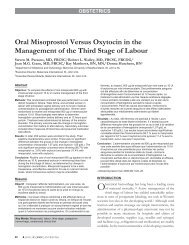Kirsten Grabowska - UBC Department of Obstetrics & Gynaecology
Kirsten Grabowska - UBC Department of Obstetrics & Gynaecology
Kirsten Grabowska - UBC Department of Obstetrics & Gynaecology
You also want an ePaper? Increase the reach of your titles
YUMPU automatically turns print PDFs into web optimized ePapers that Google loves.
122 Jacobson et alTable IV Comparison <strong>of</strong> posttreatment plasma glucose values for insulin and glyburide PERMS subgroupsInsulin Glyburide P valueFasting: No. women 122 137Fasting: Value (mg/dL)* 97.7 G 12.2 90.2 G 12.7 ! .001Fasting: No. values O100 mg/dL (%) 2182/6141 (35.5) 1044/6623 (15.8) ! .0011 h: No. women 89 1211 h: Value (mg/dL)* 137.8 G 23.6 131.4 G 23.3 ! .0011 h: No. values O155 mg/dL (%) 2182/12175 (17.9) 1772/16479 (10.8) ! .0012 h: No. women 33 162 h: Value (mg/dL)* 118.8 G 19.6 117.6 G 23.2 ! .052 h: No. values O130 mg/dL (%) 1183/4448 (26.6) 452/1873 (24.1) .04Maternal hypoglycemia: Values !60 mg/dL (%) 19/22,764 (0.08) 50/24,975 (0.20) ! .001Mean fasting and/or postprandial within goal: No. women (%) y 77 (63) 118 (86) ! .001Mean days tested z 66.7 G 34.3 62.6 G 32.2 .33Mean tests per day 2.8 2.9* Values are mean G SD.y Within goal defined as fasting !100 and either 1-h postprandial !155 or 2-h postprandial !130 mg/dL.z Calculated from date medication initiated to date <strong>of</strong> delivery.daily insulin dose was available for 249 women: mean34.4 G 28.1 U (median 28, range 2-242). Maximumdaily glyburide dose was available for 229 women: mean5.6 G 4.6 mg (median 5, range 1.25-20).Table II shows the maternal and neonatal outcomes<strong>of</strong> the insulin and glyburide groups. There were nosignificant differences for most outcomes; however,women in the glyburide group had a higher incidence<strong>of</strong> preeclampsia (12%, 6%, P = .02) and neonates in theglyburide group were more likely to receive phototherapy(9%, 5%, P ! .05). Neonates in the insulin groupwere more likely to be admitted to the NICU (24%,15%, P = .008) though they had a significantly shorterNICU length <strong>of</strong> stay compared to the glyburide group(4.3 G 9.6 vs 8.0 G 10.1 days, P = .002). No significantdifferences were noted between the 2 groups for the mostcommon discharge diagnoses in the ADT database forneonates admitted to the NICU (data not shown).Results <strong>of</strong> logistic regression analysis are shown inTable III. Adjusted ORs remain significant for preeclampsia,phototherapy, and NICU admission aftercontrolling for variables shown to differ between the 2groups. There were no neonatal deaths, lethal anomalies,or exchange transfusions in either group. Both theinsulin and glyburide groups had 4 infants with 7identified anomalies. There was 1 intrauterine fetaldemise at 37 weeks in the glyburide group.One hundred twenty two (46%) women in the insulingroup and 137 (58%) in the glyburide group werefollowed by the DHMP and had self-reported capillaryglucose values entered into the PERMS database andwere therefore easily retrievable for analysis. Women inthe glyburide group had significantly lower posttreatmentmean fasting and postprandial BSs (Table IV).Average daily testing for women on insulin was 2.8 perday compared with 2.9 per day for women on glyburide.There were no significant differences in outcomes betweenthese 2 subgroups (data not shown), exceptneonates admitted to the NICU in the glyburide grouphad a longer length <strong>of</strong> stay (2.1 G 3.9 vs 4.7 G 5.5 days,P ! .001). Maternal hypoglycemia, though rare, wasmore common in the glyburide group (0.20% vs 0.08%,P ! .001). Logistic regression modeling in thesesubgroups found that compared with insulin, glyburidetreatment was significantly more likely to be associatedwith achieving mean glucose goals (adjusted OR 0.27,95% CI 0.13-0.52).Twenty-eight (12%) women failed glyburide and wereswitched to insulin: 8 for side effects primarily attributedto hypoglycemia, 14 for poor control, and for 6 thedocumentation was unclear. These women had thefollowing characteristics (means): BMI 31.6 kg/m 2 ,fasting on GTT 104.8 mg/dL, and 25.6 lb pregnancyweight gain. Only 3 women switched for poor controlwere on maximum dose <strong>of</strong> 20 mg/d. Insulin was startedat a mean gestational age <strong>of</strong> 31.9 G 4.2 weeks andreached a mean insulin dose <strong>of</strong> 46.8 G 24.2 U/d (range5-90). Mean birth weight was 3858 g and there were nobirth injuries in this group. An additional 11 (5%)women discontinued glyburide, most for side effectsattributed to hypoglycemia, and never started insulin.These women had the following characteristics (means):BMI 30.8 kg/m 2 , fasting on GTT 94.8 mg/d, 27.7 lbpregnancy weight gain. Mean dose <strong>of</strong> glyburide was 7.2mg/d. Mean birth weight was 3893 g and there were nobirth injuries in this group.Three neonates in the insulin group had birth injuries:1 clavicle fracture, 1 brachial plexus injury, and 1 boneinjury. Eight neonates in the glyburide group had birthinjuries: 4 clavicle fractures, 1 brachial plexus injury,
















